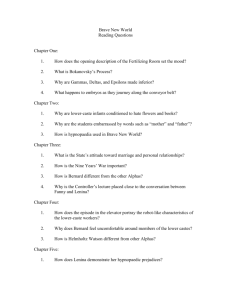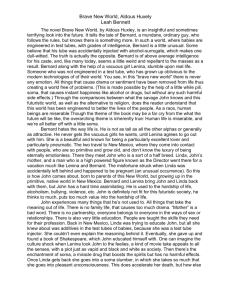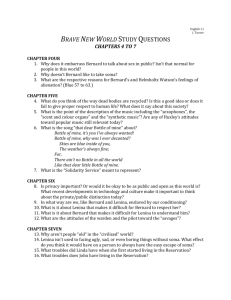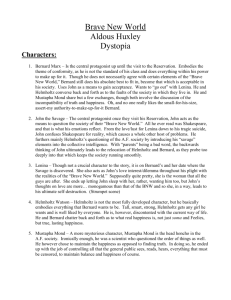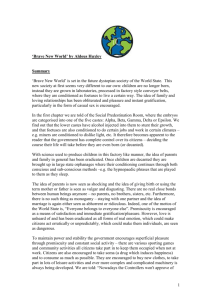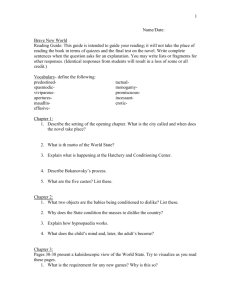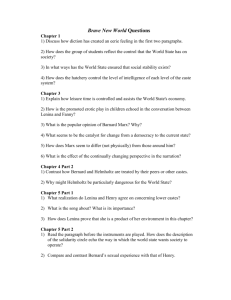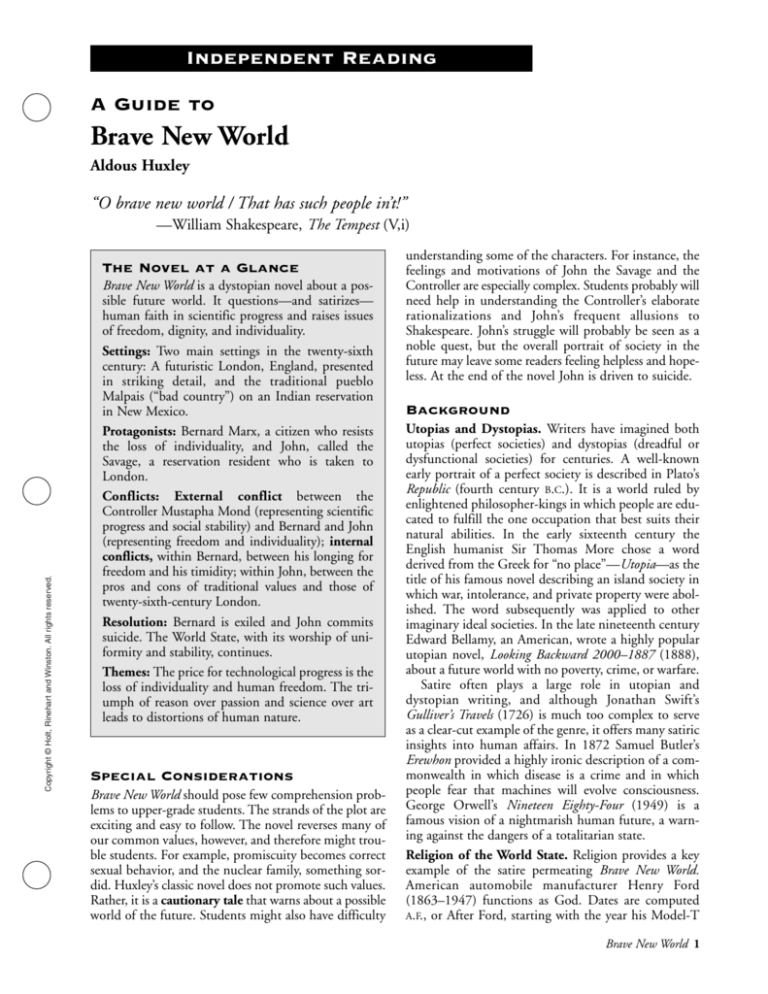
Independent Reading
A Guide to
Brave New World
Aldous Huxley
“O brave new world / That has such people in’t!”
—William Shakespeare, The Tempest (V,i)
Copyright © Holt, Rinehart and Winston. All rights reserved.
The Novel at a Glance
Brave New World is a dystopian novel about a possible future world. It questions—and satirizes—
human faith in scientific progress and raises issues
of freedom, dignity, and individuality.
Settings: Two main settings in the twenty-sixth
century: A futuristic London, England, presented
in striking detail, and the traditional pueblo
Malpais (“bad country”) on an Indian reservation
in New Mexico.
Protagonists: Bernard Marx, a citizen who resists
the loss of individuality, and John, called the
Savage, a reservation resident who is taken to
London.
Conflicts: External conflict between the
Controller Mustapha Mond (representing scientific
progress and social stability) and Bernard and John
(representing freedom and individuality); internal
conflicts, within Bernard, between his longing for
freedom and his timidity; within John, between the
pros and cons of traditional values and those of
twenty-sixth-century London.
Resolution: Bernard is exiled and John commits
suicide. The World State, with its worship of uniformity and stability, continues.
Themes: The price for technological progress is the
loss of individuality and human freedom. The triumph of reason over passion and science over art
leads to distortions of human nature.
Special Considerations
Brave New World should pose few comprehension problems to upper-grade students. The strands of the plot are
exciting and easy to follow. The novel reverses many of
our common values, however, and therefore might trouble students. For example, promiscuity becomes correct
sexual behavior, and the nuclear family, something sordid. Huxley’s classic novel does not promote such values.
Rather, it is a cautionary tale that warns about a possible
world of the future. Students might also have difficulty
understanding some of the characters. For instance, the
feelings and motivations of John the Savage and the
Controller are especially complex. Students probably will
need help in understanding the Controller’s elaborate
rationalizations and John’s frequent allusions to
Shakespeare. John’s struggle will probably be seen as a
noble quest, but the overall portrait of society in the
future may leave some readers feeling helpless and hopeless. At the end of the novel John is driven to suicide.
Background
Utopias and Dystopias. Writers have imagined both
utopias (perfect societies) and dystopias (dreadful or
dysfunctional societies) for centuries. A well-known
early portrait of a perfect society is described in Plato’s
Republic (fourth century B.C.). It is a world ruled by
enlightened philosopher-kings in which people are educated to fulfill the one occupation that best suits their
natural abilities. In the early sixteenth century the
English humanist Sir Thomas More chose a word
derived from the Greek for “no place”—Utopia—as the
title of his famous novel describing an island society in
which war, intolerance, and private property were abolished. The word subsequently was applied to other
imaginary ideal societies. In the late nineteenth century
Edward Bellamy, an American, wrote a highly popular
utopian novel, Looking Backward 2000–1887 (1888),
about a future world with no poverty, crime, or warfare.
Satire often plays a large role in utopian and
dystopian writing, and although Jonathan Swift’s
Gulliver’s Travels (1726) is much too complex to serve
as a clear-cut example of the genre, it offers many satiric
insights into human affairs. In 1872 Samuel Butler’s
Erewhon provided a highly ironic description of a commonwealth in which disease is a crime and in which
people fear that machines will evolve consciousness.
George Orwell’s Nineteen Eighty-Four (1949) is a
famous vision of a nightmarish human future, a warning against the dangers of a totalitarian state.
Religion of the World State. Religion provides a key
example of the satire permeating Brave New World.
American automobile manufacturer Henry Ford
(1863–1947) functions as God. Dates are computed
A.F., or After Ford, starting with the year his Model-T
Brave New World 1
Main Characters
(in order of appearance)
Director of Hatcheries and Conditioning (D.H.C.),
high-ranking scientist whose first name is Thomas;
Bernard Marx’s boss.
Henry Foster, red-cheeked, enthusiastic Alpha (the
highest of five classes of society), a scientist at the
Central London Hatchery.
Lenina Crowne, pretty Hatchery nurse who finds it
difficult to be as sexually promiscuous as the World
State requires; she dates Henry Foster and is attracted to
Bernard Marx and, later, to John.
Mustapha Mond, an Alpha-Plus, “his fordship,” the
Resident Controller for Western Europe, one of the Ten
World Controllers.
Bernard Marx, physically imperfect Alpha-Plus, a psychologist and somewhat paranoid loner who resists the
complete loss of his individuality.
Fanny Crowne, sensible Beta (second class) who works
in the Bottling Room. She is a friend of Lenina Crowne
but not a relative; the state distributes only ten thousand surnames among its two billion inhabitants.
Benito Hoover, Alpha who works in the Hatchery.
Like several other characters, his name refers to two different historical persons, in this instance, Benito
Mussolini, the Italian fascist leader, and Herbert
Hoover, the U.S. president.
Helmholtz Watson, Alpha-Plus; an Emotional
Engineer, writer, college lecturer, and poet; so sharp
mentally as to feel discontent; friend of Bernard Marx.
John, called the Savage, child of two members of the
World State but born and raised on a Savage (Indian)
Reservation and later taken to London; destroyed psychologically by the modern world.
Linda, John’s mother, a Beta who accidentally remained
on a Savage Reservation while pregnant with John;
embodiment of human frailty and mortality.
Plot
Chapter I. Through the device of a lecture tour for a
group of teenage Alpha boys, the first three chapters of
Brave New World provide basic exposition, describe the
setting, and introduce some of the major characters. It
is the year A.F. (After [Henry] Ford) 632 (A.D. 2545),
and the D.H.C.—the Director of Hatcheries and
Conditioning—is escorting students through the
2 Brave New World
Central London Hatchery and Conditioning Centre. A
shield over the main entrance displays the motto of the
World State, “Community, Identity, Stability.” The
D.H.C. explains the Bokanovsky fertilizing process,
which can produce up to ninety-six identical human
beings from a single egg. Embryos are “bottled” in artificial wombs and subjected to conditioning to produce
different grades, or castes, of people. The castes are
identified by the first five letters of the Greek alphabet:
alpha, beta, gamma, delta, epsilon. Conditioning guarantees that people will like being of their caste.
Chapter II. As the tour continues, the students watch
Neo-Pavlovian conditioning in which lower-caste Delta
babies are lured to colorful books and flowers, then hit
with electrical shock. Thus programmed to hate books
and nature, they will grow up to become economically
useful consumers of expensive sports gear. The D.H.C.
explains the outmoded concepts of “parents” and
“birth,” terms now considered smutty, and tells how
hypnopaedia, or sleep-teaching, came to be used not for
intellectual, but for moral, education.
Chapter III. Exposition continues outdoors. The students watch children playing erotic games. They are
stunned to learn that such play was once considered
abnormal and immoral. Rising action begins when the
students and the D.H.C. encounter Mustapha Mond.
From this point onward, the omniscient narrator
alternates bits of different scenes and conversations to
show that they are occurring simultaneously. Separated
out, the scenes develop as follows: (1) Controller Mond
explains to the students about the squalor of homes and
the horror of families in the old society and describes
the insanity of monogamy and romance. He lectures on
history, including the Nine Years’ War needed to inaugurate the World State, and such obstacles to progress
and stability as Christianity, democracy, liberalism, and
open access to books and knowledge of history. (2)
Henry Foster and the Assistant Predestinator discuss
the latest “feely” (a movie that affects touch and smell).
(3) Lenina and Fanny change in the women’s locker
room and discuss their sex lives, particularly Lenina’s
tendency to date one man exclusively, as she has Henry
Foster for the last four months, and her attraction to
Bernard Marx. (4) In the nurseries, hypnopaedic suggestions continue to shape children’s attitudes.
Chapter IV. Lenina arranges a July trip to the Savage
Reservation in New Mexico with Bernard. She then flies
off to play Obstacle Golf with Henry Foster, and
Bernard is joined by his friend Helmholtz Watson. We
learn about the internal conflicts of these two men.
The physically imperfect Bernard feels inadequate and
out of place in the Alpha caste. The physically and mentally gifted Helmholtz is intellectually discontent; he
longs to write about something of genuine importance.
Chapter V. After golf Lenina and Henry discuss the
castes, whose bodies are all of equal chemical value, and
Lenina recalls a time in childhood when she awoke
Copyright © Holt, Rinehart and Winston. All rights reserved.
car was first produced (1913); and Ford’s assembly-line
method for cost-effective production of identical vehicles has been adapted to the production of human
beings. Ritual Solidarity Services occur in the Fordson
Community Singery, a building boasting a clock called
Big Henry. Ford’s Day is a major festival. People speak
of “Our Ford,” make “the sign of the T,” and say that
“Ford’s in his flivver; all’s well with the world.”
Copyright © Holt, Rinehart and Winston. All rights reserved.
during the night and became aware of hypnopaedic
teaching. They go on to dinner and dancing, their experiences channeled and heightened by the drug soma.
Bernard attends his required Solidarity Service. People
sing hymns, consume soma, drink to the Coming of the
Greater Being, and collapse exhausted into an “Orgyporgy.” Bernard is painfully aware of his inability to
become one with the others.
Chapter VI. The chapter develops in three scenes. (1)
Lenina recalls her first date with Bernard. He wanted to
contemplate nature, refused soma, said he did not want
to be merely a part of the social body, and even wondered what it would be like not to be enslaved by conditioning. (2) Bernard asks the D.H.C. for permission
to visit the New Mexican Reservation. The Director
tells Bernard that he too once took a trip to New
Mexico, where the woman accompanying him disappeared. Embarrassed at having shared a personal anecdote, the Director severely warns Bernard to conform
to proper standards of “infantile” behavior. (3) Bernard
and Lenina fly to Santa Fe. Phoning home, Bernard
learns that the D.H.C. plans to move him to Iceland.
to his head. John tours a factory and is sickened at seeing groups of identical human beings who were created
to suit each task. Eton, the famous school, bewilders
him, and the feely he attends with Lenina disgusts him.
He takes her home and leaves. She finds solace in soma;
he rereads Shakespeare’s Othello.
Chapter XII. John refuses to attend a party Bernard
arranges, and those who expected to see “the Savage” treat
Bernard with contempt. Bernard has grown jealous of
John’s friendship with Helmholtz, a friendship strengthened by their mutual love of poetry. Yet Helmholtz hurts
John by laughing uncontrollably at the “ridiculous” situations on which Romeo and Juliet is based.
Chapter VII. Bernard and Lenina enter the pueblo of
Malpais, an Indian community Linda finds filthy and
incomprehensible. Bernard reminds her with irony of
the motto “Civilization is sterilization.” They witness a
violent snake dance, which culminates in a boy’s being
whipped. John, a blond man in Indian garb, explains the
ritual and says he wishes he had been sacrificed. He tells
them that his mother, Linda, came from the “Other
Place” and was abandoned by his father, Tomakin.
(Bernard recalls that the D.H.C.’s first name is Thomas.)
Linda greets Lenina with excitement and laments the
primitive way of life she has had to endure for years.
Chapter XIV. In the Hospital for the Dying, John sits at
Linda’s bedside and recalls the events of their life together.
A group of children engaged in death-conditioning overrun the hospital ward and outrage John. Linda dies in
soma-caused confusion, and John sobs uncontrollably. In
his grief he keeps repeating, “God, God, God.”
Chapter VIII. In a series of flashbacks, John recalls his
mother’s male visitors, a time when the village women
attacked her for her promiscuity, and her stories of the
Other Place, where everyone is clean and happy. Popé,
Linda’s main lover, brought her the works of
Shakespeare, and John was enthralled with the magic of
the words. He also recounts his trying to kill Popé and
having to watch the wedding of the girl he loved and
not being allowed to participate in an initiation rite.
Bernard understands that both he and John are outsiders in their worlds. In the main plot complication,
he invites John and Linda to London.
Chapter IX. Bernard flies to Santa Fe and arranges to
bring John and Linda to London as scientific curiosities.
Chapter X. In London the D.H.C. summons Bernard
in order to punish him publicly for unorthodox behavior. In his defense Bernard produces the all-too-human
Linda. She recognizes the Director as the Tomakin who
made her “have a baby,” and when John addresses the
Director as “My father,” the humiliated D.H.C. flees.
Chapter XI. Over the ensuing weeks Linda retreats
into a soma stupor. Bernard’s success as a social lion goes
Chapter XIII. Lenina struggles with the strange feeling
of wanting only one man, John. She visits him, and
John confesses his love for her. He has wanted to do
something to show that he is worthy of her and now
wants to marry her. She is shocked by the suggestion
and confused by his use of lines from Shakespeare. She
undresses and offers herself to him, but he is appalled.
He calls her a whore and slaps her. While she dresses,
John receives a call and rushes out: someone is dying.
Chapter XV. John encounters a group of hospital workers receiving their daily soma ration. Telling them the
drug is poison, he begins throwing soma tablets out a
window. Bernard and Helmholtz arrive, and Helmholtz
helps John fight off the furious and uncomprehending
mob, while Bernard stands by indecisively. The police
quell the riot and arrest Bernard, John, and Helmholtz.
Chapter XVI. Chapters XVI and XVII develop the
novel’s main themes. The three men appear before
Controller Mustapha Mond, who reveals that he, too,
has read Shakespeare. He explains that it is now prohibited because it is old and beautiful: people can be
allowed to like only new things. Besides, they would not
understand anything that did not mirror their own perfectly stable world. The price of stability is the end of
art; the caste system and the muzzling of science are also
necessary to the smooth functioning of society. Bernard
begs abjectly not to be exiled to Iceland; Helmholtz
seems happy to choose exile to the Falkland Islands.
Chapter XVII. Alone with John, the Controller produces religious and philosophical books, including the
Bible. He reads passages about God and discusses God
and the meaning of life with John. The Controller
remarks that there probably is a God, although He now
manifests himself as an absence. He asserts that people
believe only what they are conditioned to believe. John
quotes Shakespeare in favor of nobility and human dignity—qualities not needed by society, according to the
Brave New World 3
Approaches for
Post-Reading Activities
Discussion groups or students doing individual
research projects might focus on the following activities.
1. Evaluating Brave New World ’s Predictions
Discussion groups might share their observations on
whether or not some of Huxley’s predictions seem to
be drawing closer to reality:
• Mega-corporations and mega-governments running
things
• Technology replacing human contact
• Virtual reality replacing real experiences
2. Extending the Novel
Students might extend an idea from the novel in an
expository essay:
• The motto of the World State is “Community,
Identity, Stability.” What motto might characterize
contemporary American society?
• If you were one of the Ten World Controllers, what
changes would you try to impose? Why would you
make each change?
3. Researching and Explaining Allusions
Students might research some of Brave New World ’s
allusions and explain what they add to the novel’s
themes:
Copyright © by Holt, Rinehart and Winston, Inc.
All rights reserved. No part of this publication may be reproduced
or transmitted in any form or by any means, electronic
or mechanical, including photocopy, recording, or any information
storage and retrieval system.
Printed in the United States of America
4 Brave New World
• The historical names borne by many characters:
Marx, Lenina (Lenin), Benito Hoover, Diesel,
Engels, Bokanovsky, Bakunin, Darwin, Bonaparte
• New Mexico: the mesa city of Acoma, the Zuñi
people, the Penitentes cult
• Allusions to Shakespeare’s works in the novel’s title
and in the body of the work. Students might particularly benefit by comparing the characters,
action, and themes of Shakespeare’s The Tempest
with those of Brave New World.
Meet the Writer
Aldous Huxley (1894–1963) was the grandson of the
great nineteenth-century biologist Thomas Huxley. He
attended Oxford University, was employed in a government office during World War I, and was a schoolmaster
at Eton. He later lived in the United States for many years
and died there. Huxley was a prolific writer, producing
novels, plays, and a long list of essays on a wide variety of
social, cultural, historical, and literary topics. His “novels
of ideas” have sometimes been criticized as fictionalized
essays that make intellectual points instead of presenting
fully realized characters. Nevertheless, Brave New World
(1932) has remained a widely read evocation of the
possible future of human civilization.
Read On
Aldous Huxley, Brave New World Revisited. Huxley’s
1958 observations on a variety of social, scientific, and
historical topics, including the opinion that some of his
“prophecies” (social conditioning, drug use, loss of
individuality) were rapidly coming true.
Jonathan Swift, Gulliver’s Travels. A classic English
satire on human nature, human foibles, and social
structures.
T. S. Eliot, “The Hollow Men.” A 1925 modernist
poem that explores the loss of vitality and individuality
in the twentieth century.
W. H. Auden, “The Unknown Citizen.” Ironic and
satiric poem in the form of an inscription on a monument to a model citizen.
George Orwell, Nineteen Eighty-Four. A dystopian
novel, published in 1949, about a future totalitarian
world. It is a world ruled by “Big Brother,” in which
language is perverted for the purposes of the state and
private life is virtually annihilated.
Copyright © Holt, Rinehart and Winston. All rights reserved.
Controller, because all struggle has been eliminated. John,
however, continues to claim the right to be uncomfortable and unhappy.
Chapter XVIII. Bernard and Helmholtz bid farewell to
John, who is ordered to stay in London as a continuing
experiment; but he escapes and makes an abandoned
lighthouse his hermitage. One day outsiders spot him
whipping himself in self-purification, and reporters
invade his retreat, leading to the climax of the story.
John drives the reporters away, but Darwin Bonaparte
secretly films John whipping himself to banish thoughts
of Lenina. Bonaparte’s feely, The Savage of Surrey, brings
a throng of curiosity seekers to John’s lighthouse. They
swarm around him, treating him like a zoo animal and
begging him to use the whip. He is driven to do so at the
sight of Lenina. An Orgy-porgy of frenzied sensuality
breaks out, and when John later awakens from it, he is
overcome with remorse and despair. The next day people discover that he has hanged himself.

